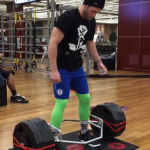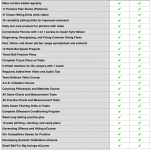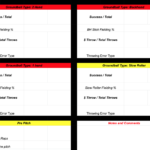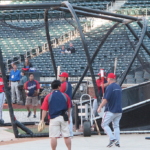A new take on an old hitting tool
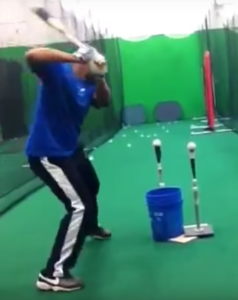 Tee work is often nostalgically viewed by many baseball coaches as the be all, end all of creating a good hitter. Coaches often recommend swinging as much as 200-250 swings per day off the tee.
Tee work is often nostalgically viewed by many baseball coaches as the be all, end all of creating a good hitter. Coaches often recommend swinging as much as 200-250 swings per day off the tee.
If a player strikes out twice and pops-up twice in a game, the prescription is to go hit off a tee. There must be something wrong mechanically if a player is not having success, right?
Perhaps there are other reasons the player isn’t having success. Maybe their timing is off. Maybe they are struggling recognizing pitches and locations. Maybe they put really good swings on really good pitches to hit and just missed hitting a speeding sphere that could move any direction with a round object squarely (sounds really difficult when we say it like that!!)
Those are major components of hitting that can be totally ignored if tee work is done incorrectly. Additionally, the belief that taking hundreds of swings off a tee and making mechanical tweaks will be the magic elixir to fix all that ails a hitter and can lead to an over reliance on mechanics.
Get 5 drills that translate batting practice skill to game performance
The batting tee can be used to create skills and can be a useful tool when you have a large number of players with a limited hitting facility. Many coaches notice immediately that as soon as the ball is traveling toward the hitter, everything they have done on the tee goes completely out the window.
The theory is that if you practice hitting off a tee, you will develop muscle memory and when it comes time to compete, you will revert to the swing you have developed on the tee. I do certainly believe that there is some merit to that thought, however, there is often a missing component of hitting off a tee, reaction.
This article will help you explore ways to make tee work more challenging and as game like as possible.
Swinging vs. Hitting
There is a big difference between the ability to swing, and the ability to hit. Many coaches and players oversimplify “hitting” as just developing a good “swing,” and tend to put an overemphasis on the swing to create a good hitter.
Successful hitters do four things well, they have a mechanically sound and athletic swing, they can recognize pitches (pitch location and pitch type), they swing at good pitches to hit, and they are on time with the pitches they swing at. It could be argued that a mechanically sound, athletic swing would be the LEAST important of the four components of being a good hitter.
Get 5 drills that translate batting practice skill to game performance
Imagine a hitter who has great bat speed and a mechanically sound swing who can’t recognize pitches out of the hand, doesn’t swing at good pitches to hit, and is either early or late on most pitches. All that work on the swing, and the player doesn’t have much of a chance to hit in the games.
Now let’s imagine a hitter who has an average swing mechanically, but recognizes pitches well, swings at good pitches, lays off bad pitches, and is on time with the ball. That hitter, has a pretty good chance of success.
Tee work can help develop that athletic swing, but it lacks in developing pitch recognition, good timing, and a good approach at the plate.
Why tee work can be detrimental
Just like any other tool, if used incorrectly, the batting tee can be detrimental to a hitter’s ability to hit live pitching in the game. One of the worst ways hitters can use a batting tee is looking at the quantity of swings vs. the quality of swings. Two hundred unfocused, undisciplined swings will not make the hitters’ swing any better, it will just reinforce negative habits, and get them used to swinging without making a decision.
The other major problem with tee work is players and coaches tend to use it as a crutch for when hitters go into slumps. Go 0-10? Take 200 swings on the tee. Even if those swings are focused on making an appropriate mechanical adjustment, the time spent there will do nothing to improve pitch recognition, pitch selection, or timing which are more likely to be the real issue at hand.
So, what is a batting tee good for?
The batting tee can be a great tool to help a player learn what really develops a powerful swing that can drive the baseball. While there may be a bit of over emphasis on exit velocity in the showcase world, exit velocity can be an extremely useful teaching tool because players can develop and change their swing in a controlled environment learning the proper sequencing of the swing to maximize their explosiveness and power.
In order to utilize these aspects of creating a good swing (explosiveness and swing plane) on the tee, have your player follow these steps:
- Set the tee up 3-4 feet from the net they are hitting against.
- Focus on swinging from the ground up (incorporating lower body in each swing)
- Take each swing with 100% effort.
- Have the player try to hit the ball at a slight upward angle so the ball hits the net about 10-15 inches above the tee.
- Use a radar gun to measure and track exit velocity occasionally.
- Transfer that swing to front toss and live batting practice as soon as possible.
- Use tee work to reinforce swing plane, proper swing sequencing, and make any swing adjustments.
Making the tee more game-like
One of the major draw backs to tee work is that the player doesn’t have to make a decision prior to swinging, and they are often woking on swinging at just one pitch, the pitch right down the middle. Here are three drills you can do to make your tee work more productive, and more game-like:
Random Tee: Don’t just work a swing, work all of your swings. Move the tee height, depth, and distance from the hitter on each swing so that no two consecutive swings are the same. To simulate pitches inside, the tee will need to be out toward (or in front of) the hitter’s front foot. To simulate outside pitches, the tee will need to be back toward the middle of the hitter’s body.
Get 5 drills that translate batting practice skill to game performance
Take Drill: As the hitter begins his load, their partner will either say nothing and the hitter will swing as usual, or they will say “take.” If the partner says “take,” the hitter should freeze when their heel hits the ground and check their hitting position. They should have their hands slightly up and back between their back shoulder and elbow, and the knob of their bat pointing to the catcher’s feet. If any part of the body has begun the swing, it should be the lower half and back knee, not the hands or upper body.
Inside/Outside with Take: Set up a tee on the inside of the plate off the front foot, and one on the outside of the plate off the middle of the body. When the hitter begins his stride and load phase, their partner will either say “inside,” “outside,” or “take.” If they say “inside’ or “outside” the hitter will hit the corresponding ball. If they say “take” the hitter will freeze in their hitting position. Make sure the partner giving the direction does so with enough time that they can process and swing at the proper ball.
It is amazing how making just a few changes to tee work can make it much more productive and more likely to translate into games.
For more great hitting drills that will help players make decisions, and become productive hitters in games, get FREE access to our 5 hitting drills that translate practice skills to game performance here ~~~> www.cornerstonecoachingacademy.com/5-drills
 Posted by Kyle Nelson
Posted by Kyle Nelson- Posted in Hitting
 Jun, 14, 2017
Jun, 14, 2017 No Comments.
No Comments.
Elite members login here
Check out what’s New/Hot!
Recognizing, Diagnosing, and Fixing Common Hitting Flaws eCourse The 3 metrics we tested on Blast motion sensors this year Sneak Peek Inside an Elite Q and A The batting practice continuum Elite Member’s area table of contents 50+ “Chaos” hitting drills
5 sample Chaos hitting drills FREE
Mental Skills and Culture Building The hitting pyramid Welcome Elite Member, Trey! Ideas for a pitcher first practice 12 week bat speed improvement plan Make plans this offseason to have your team playing their best baseball at the end of the year” Top 5 hitting drills to translate practice skill to game performanceHow we used Blast Motion sensors with a team in 2019
What to do if your hitters are overmatched Welcome Elite Member, Tommy! Setting your baserunners up for success Welcome Elite Member, Mike! A consulting call with Elite Member Matt FREE Web Clinic: Developing Athletic, Consistent, Extraordinary Infielders
 Coach Kyle Nelson
Coach Kyle Nelson
